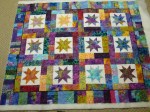
The first quilt to have my new label on the back!
I’ve been thinking for some time that I’d like a “standard” Zippy Quilts label to sew into the binding of my quilts in addition to the usual label I put on with the name of the quilt and the date. I’ve seen several such labels and think they look cool. They make me think the creator takes herself and her work seriously enough to have a professional label.
I collected a bunch of ideas for making labels on my Pinterest page, here, if you want to look. Pinterest is great for gathering idea from around the web and organizing them all in one place. I also got some of those ideas by doing a search within Pinterest for “fabric labels”, which lead me to things other people had discovered.
It boiled down to just a few good options in 3 categories:
1. Print your own labels, sort of like I do my labels with the quilt name/date/etc. This would be fairly economical despite the cost of printable fabric, because the labels are small. However, the washability of some of the printable fabrics was in question, and there would be the need to finish the edges in some way to avoid fraying. Nevertheless, there’s a very nice tutorial on how to do it here, on the Emmaline blog.
2. Get commercially-made labels, either woven or printed, from specialty companies that make them. There are lots of companies that offer lots of different labels, from laundry tags like you sew into your kids’ clothes before they go to camp to really professional woven labels. The cost varies a lot, too. The main drawback was that, for the better looking ones, you have to order an awful lot. What if I had 1000 labels I didn’t much care for?
3. Design your own at Spoonflower and have them printed up on fabric for you to cut apart into labels. There’s a tutorial on how to do it here, on a nice blog called “While They Snooze”. This is what I ultimately decided to do. They’ll print either a sample or a fat quarter (FQ) for you, so I ordered FQs of 2 different layouts to see if I liked them.

Spoonflower labels–first layout
I cut them apart with pinking shears to avoid a hard edge and sewed a little hem around each one to prevent fraying. I think another time I’d make them a little smaller, but this is a good start. The Spoonflower site is easy enough to use that I never even had to contact them for help.

The second layout
My second layout left space below my name on each label so that I could cut out the label, hem the sides only, and then fold it in half, inserting the remaining raw edges in the binding. This avoids the need to sew it down separately on 4 sides. I may like this better, but I haven’t had time to try them much yet. The first one is going on my Quilt Alliance donation quilt, which I’m still binding. I think I’ll go back and put them on all this year’s projects.
If you get some labels made for your projects, write and let me know what you did and how it worked out.

Label on Quilt Alliance quilt back
 Here’s the UFO finish for May, which barely got done among all the other projects in May! It is a donation quilt made out of orphan blocks; I’ve made a couple of similar ones in the past year because there were a LOT of these blocks! I actually made the quilt top in September of last year to demonstrate use of improvised sashing, and then the top kind of languished. When it came up as the finish for May I had already chosen the binding, so it was actually pretty quick to finish.
Here’s the UFO finish for May, which barely got done among all the other projects in May! It is a donation quilt made out of orphan blocks; I’ve made a couple of similar ones in the past year because there were a LOT of these blocks! I actually made the quilt top in September of last year to demonstrate use of improvised sashing, and then the top kind of languished. When it came up as the finish for May I had already chosen the binding, so it was actually pretty quick to finish. I love the striped fabric for binding, an idea I got from Rita over at RedPepperQuilts.com. She makes beautiful quilts!
I love the striped fabric for binding, an idea I got from Rita over at RedPepperQuilts.com. She makes beautiful quilts!
























